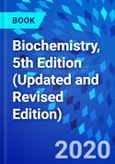Renowned and recommended textbook in the subject that explains the basic concepts in concise manner.
- is an amalgamation of medical and basic sciences, and is comprehensively written and later revised and updated to meet the curriculum requirements of Medical, Pharmacy, Dental, Veterinary, Biotechnology, Agricultural Sciences, Life Sciences students, and others studying Biochemistry as one of the subjects. This book fully satisfies the revised MCI competency-based curriculum.
- is the first textbook on Biochemistry in English with multicolor illustrations by an Asian author. The use of multicolors is for a clear understanding of the complicated structures and reactions.
- is written in a lucid style with the subject being presented as an engaging story growing from elementary information to the most recent advances and with theoretical discussions being supplemented with illustrations, tables, biomedical concepts, clinical correlates, and case studies for an easy understanding of Biochemistry.
- has each chapter beginning with a four-line verse followed by the text with clinical correlates, a summary, and self-assessment exercises. The lively illustrations and text with appropriate headings and sub-headings in bold type faces facilitate reading path clarity and quick recall. All this will help the students to master the subject and face the examinations with confidence.
- provides the most recent and essential information on Molecular Biology and Biotechnology, and current topics such as Diabetes, Cancer, Free Radicals and Antioxidants, Prostaglandins, etc.
- describes a wide variety of case studies (77) with biomedical correlations. They are listed at the end of relevant chapters for immediate reference, quick review, and better understanding of Biochemistry.
- contains the basics (Bioorganic and Biophysical Chemistry, Tools of Biochemistry, Immunology, and Genetics) for beginners to learn easily Biochemistry, origins of biochemical words, confusables in Biochemistry, principles of Practical Biochemistry, and Clinical Biochemistry Laboratory.
Table of Contents
Section I - Chemical Constituents of Life 1. Biomolecules and the cell 2. Carbohydrates 3. Lipids 4. Proteins and amino acids 5. Nucleic acids and nucleotides 6. Enzymes 7. Vitamins Section II - Physiological Biochemistry 8. Digestion and absorption 9. Plasma proteins 10. Hemoglobin and porphyrins 11. Biological oxidation Section III - Metabolisms 12. Introduction to metabolism 13. Metabolism of carbohydrates 14. Metabolism of lipids 15. Metabolism of amino acids 16. Integration of metabolism 17. Metabolism of nucleotides 18. Mineral metabolism Section IV - Clinical Biochemistry and Nutrition 19. Hormones 20. Organ function tests 21. Water, electrolyte and acid-base balance 22. Tissue proteins and body fluids 23. Nutrition Section V - Molecular Biology and Biotechnology 24. DNA-replication, recombination and repair 25. Transcription and translation 26. Regulation of gene expression 27. Recombinant DNA and biotechnologySection VI - Current Topics 28. Human genome project 29. Gene therapy 30. Bioinformatics 31. Metabolism of xenobiotics (detoxification) 32. Prostaglandins and related compounds 33. Biological membranes and transport 34. Free radicals and antioxidants 35. Environmental biochemistry 36. Insulin, glucose homeostasis, and diabetes mellitus 37. Cancer 38. Acquired immunodeficiency syndrome (AIDS)
Section VII - Basics to Learn Biochemistry 39. Introduction to bioorganic chemistry 40. Overview of biophysical chemistry 41. Tools of biochemistry 42. Immunology 43. Genetics
Appendices Answers to self-assessment exercises I. Abbreviations used in this book II. Origins of important biochemical words III. Common confusables in biochemistry IV. Practical biochemistry-principles V. Clinical biochemistry laboratory VI. Case studies with biochemical correlations








